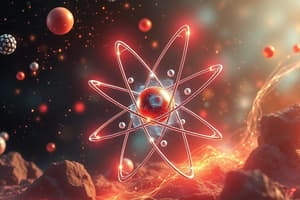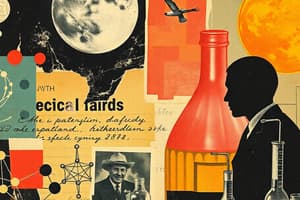Podcast
Questions and Answers
Which statement correctly links experimental evidence to the development of atomic theory?
Which statement correctly links experimental evidence to the development of atomic theory?
- Dalton's observations of chemical reactions, showing elements combine in fixed ratios, supported the concept of indivisible atoms. (correct)
- Thomson's cathode ray experiment revealed the existence of neutrons, leading to the conclusion that atoms have a neutral charge.
- The deflection of alpha particles supported Thomson's plum pudding model.
- Rutherford's gold foil experiment demonstrated that atoms are indivisible and the fundamental building blocks of matter, disproving Dalton's initial postulates.
How did Rutherford's gold foil experiment contribute to the understanding of atomic structure?
How did Rutherford's gold foil experiment contribute to the understanding of atomic structure?
- It confirmed that electrons are evenly distributed throughout the atom, similar to plums in a pudding.
- It demonstrated that atoms are mostly empty space with a small, dense, negatively charged nucleus.
- It proved that atoms are indivisible and uniform spheres of matter.
- It revealed that atoms consist of a small, dense, positively charged nucleus surrounded by mostly empty space. (correct)
Which of the following statements best explains why atomic models have changed over time?
Which of the following statements best explains why atomic models have changed over time?
- Atomic models are modified to align with advancements in mathematical theories, regardless of experimental evidence.
- Atomic models evolve as scientists gather new experimental evidence that either supports, contradicts, or refines existing models. (correct)
- Atomic models are hypothetical constructs that change randomly without any specific reason.
- Atomic models are based on philosophical interpretations and change with societal preferences.
How did Thomson's cathode ray experiment change the existing atomic model?
How did Thomson's cathode ray experiment change the existing atomic model?
Why is the concept of electrical forces crucial to understanding the behavior of atoms and molecules?
Why is the concept of electrical forces crucial to understanding the behavior of atoms and molecules?
Why do stable systems form when attractive and repulsive forces are balanced?
Why do stable systems form when attractive and repulsive forces are balanced?
How does the strength of intermolecular forces influence the temperature of a phase change?
How does the strength of intermolecular forces influence the temperature of a phase change?
If a new experiment showed that the nucleus of an atom could be further divided into smaller particles, how would this affect our current atomic theory?
If a new experiment showed that the nucleus of an atom could be further divided into smaller particles, how would this affect our current atomic theory?
Rutherford's gold foil experiment led to which significant conclusion about the structure of an atom?
Rutherford's gold foil experiment led to which significant conclusion about the structure of an atom?
How did Bohr's model refine Rutherford's model of the atom?
How did Bohr's model refine Rutherford's model of the atom?
Which concept introduced by Thomson's plum pudding model was a departure from Dalton's atomic model?
Which concept introduced by Thomson's plum pudding model was a departure from Dalton's atomic model?
What is the fundamental difference between a scientific theory and an everyday theory?
What is the fundamental difference between a scientific theory and an everyday theory?
Which of the following statements accurately reflects a concept that has remained consistent across various atomic theories from Dalton to Bohr?
Which of the following statements accurately reflects a concept that has remained consistent across various atomic theories from Dalton to Bohr?
If a scientist observes new evidence that contradicts a well-established scientific theory, what is the most appropriate course of action according to scientific principles?
If a scientist observes new evidence that contradicts a well-established scientific theory, what is the most appropriate course of action according to scientific principles?
In what way did Bohr's model address a limitation of Rutherford's model?
In what way did Bohr's model address a limitation of Rutherford's model?
A researcher is reviewing experimental data that suggests a previously unknown subatomic particle exists. Which atomic model would be most challenged by this discovery?
A researcher is reviewing experimental data that suggests a previously unknown subatomic particle exists. Which atomic model would be most challenged by this discovery?
What happens to the kinetic energy of two atoms as they approach each other and their potential energy decreases?
What happens to the kinetic energy of two atoms as they approach each other and their potential energy decreases?
Why does potential energy increase as two atoms are separated?
Why does potential energy increase as two atoms are separated?
During atomic collisions, what determines whether energy is transferred into or out of a system?
During atomic collisions, what determines whether energy is transferred into or out of a system?
If a fast-moving atom collides with a slower-moving atom, what is the most likely outcome regarding energy transfer?
If a fast-moving atom collides with a slower-moving atom, what is the most likely outcome regarding energy transfer?
Which of the following factors primarily determines the strength of London Dispersion Forces (LDF) between atoms or molecules?
Which of the following factors primarily determines the strength of London Dispersion Forces (LDF) between atoms or molecules?
How does increasing the strength of London Dispersion Forces typically affect the melting and boiling points of a substance?
How does increasing the strength of London Dispersion Forces typically affect the melting and boiling points of a substance?
Which of the following diatomic molecules would you expect to have the highest boiling point, based on London Dispersion Forces alone?
Which of the following diatomic molecules would you expect to have the highest boiling point, based on London Dispersion Forces alone?
Consider two noble gases, Helium (He) and Xenon (Xe). Which would exhibit stronger London Dispersion Forces, and why?
Consider two noble gases, Helium (He) and Xenon (Xe). Which would exhibit stronger London Dispersion Forces, and why?
Which of these diatomic molecules would you expect to have the lowest boiling point?
Which of these diatomic molecules would you expect to have the lowest boiling point?
What characteristic of an atom primarily determines the strength of London Dispersion Forces?
What characteristic of an atom primarily determines the strength of London Dispersion Forces?
Why do noble gases like helium not readily form chemical bonds?
Why do noble gases like helium not readily form chemical bonds?
Concerning energy changes during atomic interactions, how does the 'combination' of two helium atoms compare to that of two hydrogen atoms?
Concerning energy changes during atomic interactions, how does the 'combination' of two helium atoms compare to that of two hydrogen atoms?
Which statement correctly contrasts London Dispersion Forces and covalent bonds?
Which statement correctly contrasts London Dispersion Forces and covalent bonds?
If you increase the size of the electron cloud of an atom, what happens to the boiling point?
If you increase the size of the electron cloud of an atom, what happens to the boiling point?
What type of molecules exhibit only London Dispersion Forces?
What type of molecules exhibit only London Dispersion Forces?
Consider three substances: nitrogen (N$_2$), chlorine (Cl$_2$), and bromine (Br$_2$). Assuming similar molecular shapes, how would you rank them in terms of increasing boiling point?
Consider three substances: nitrogen (N$_2$), chlorine (Cl$_2$), and bromine (Br$_2$). Assuming similar molecular shapes, how would you rank them in terms of increasing boiling point?
Which statement best describes the key difference between Thomson's plum pudding model and Rutherford's model of the atom?
Which statement best describes the key difference between Thomson's plum pudding model and Rutherford's model of the atom?
What evidence contradicted Dalton's initial atomic theory?
What evidence contradicted Dalton's initial atomic theory?
Which of the following is a similarity between gravitational and electrostatic forces?
Which of the following is a similarity between gravitational and electrostatic forces?
What causes the initial attraction between two isolated atoms as they get closer to each other?
What causes the initial attraction between two isolated atoms as they get closer to each other?
Why do atoms repel each other when they become very close?
Why do atoms repel each other when they become very close?
As two isolated helium atoms approach one another, what happens to the potential energy of the system?
As two isolated helium atoms approach one another, what happens to the potential energy of the system?
As two isolated helium atoms approach each other and experience repulsive forces, what happens to their kinetic and total energy?
As two isolated helium atoms approach each other and experience repulsive forces, what happens to their kinetic and total energy?
Flashcards
Atom
Atom
The smallest distinguishable part of an element, making up all matter.
Models in Chemistry
Models in Chemistry
Using representations (mental or physical) to understand chemical entities.
Scientific Theory
Scientific Theory
A scientific explanation that changes with new evidence.
Intermolecular Attractions
Intermolecular Attractions
Signup and view all the flashcards
Electrons
Electrons
Signup and view all the flashcards
Nucleus
Nucleus
Signup and view all the flashcards
Dalton's Atomic Theory
Dalton's Atomic Theory
Signup and view all the flashcards
J.J. Thomson
J.J. Thomson
Signup and view all the flashcards
Dalton's Atomic Model (1803)
Dalton's Atomic Model (1803)
Signup and view all the flashcards
Thomson's Atomic Model (1897)
Thomson's Atomic Model (1897)
Signup and view all the flashcards
Rutherford's Atomic Model (1911)
Rutherford's Atomic Model (1911)
Signup and view all the flashcards
Bohr's Atomic Model (1913)
Bohr's Atomic Model (1913)
Signup and view all the flashcards
Everyday Theory
Everyday Theory
Signup and view all the flashcards
Consistent Idea: Atoms as Building Blocks
Consistent Idea: Atoms as Building Blocks
Signup and view all the flashcards
Consistent Idea: Different Elements
Consistent Idea: Different Elements
Signup and view all the flashcards
Electrostatic Force
Electrostatic Force
Signup and view all the flashcards
Gravitational Force
Gravitational Force
Signup and view all the flashcards
Similarities Between Electrostatic and Gravitational Forces
Similarities Between Electrostatic and Gravitational Forces
Signup and view all the flashcards
Atomic Attraction and Repulsion
Atomic Attraction and Repulsion
Signup and view all the flashcards
Polarizability
Polarizability
Signup and view all the flashcards
Intermolecular Forces
Intermolecular Forces
Signup and view all the flashcards
London Dispersion Forces (LDF)
London Dispersion Forces (LDF)
Signup and view all the flashcards
Helium 'Combination' Energy Change
Helium 'Combination' Energy Change
Signup and view all the flashcards
Hydrogen 'Combination' Energy Change
Hydrogen 'Combination' Energy Change
Signup and view all the flashcards
Higher Polarizability
Higher Polarizability
Signup and view all the flashcards
London Dispersion Forces
London Dispersion Forces
Signup and view all the flashcards
Covalent Bonds
Covalent Bonds
Signup and view all the flashcards
He Atom Potential Energy
He Atom Potential Energy
Signup and view all the flashcards
Energy Conservation in Atom Approach
Energy Conservation in Atom Approach
Signup and view all the flashcards
Energy Transfer via Collision
Energy Transfer via Collision
Signup and view all the flashcards
Adding Energy via Collision
Adding Energy via Collision
Signup and view all the flashcards
Removing Energy via Collision
Removing Energy via Collision
Signup and view all the flashcards
London Dispersion Forces (LDF) & Size
London Dispersion Forces (LDF) & Size
Signup and view all the flashcards
LDF Strength Ranking
LDF Strength Ranking
Signup and view all the flashcards
LDFs & Boiling/Melting Points
LDFs & Boiling/Melting Points
Signup and view all the flashcards
Study Notes
- Matter consists of atoms, the smallest distinguishable part of an element.
- Scientific models, both mental and physical, are used to represent chemical entities for various purposes.
- Scientific theories, like atomic theory, evolve as new evidence becomes available.
- All atoms/molecules are attracted to each other due to electrical forces.
- Attractions decrease a system's potential energy; repulsions increase it.
- Stable systems are achieved when attractive and repulsive forces are balanced.
- The strength of intermolecular forces influences the temperature at which a phase change occurs.
Existence of Atoms
- Claim: Atoms are the fundamental constituents of matter.
- Evidence: Dalton's Atomic Theory (1803) suggested that elements are composed of indivisible atoms and combine in fixed ratios during chemical reactions.
- Reasoning: The predictable behavior of substances in reactions and the conservation of mass support the existence of atoms.
Existence of Electrons
- Claim: Atoms contain negatively charged particles called electrons.
- Evidence: J.J. Thomson's cathode ray experiment (1897) showed that cathode rays are deflected by electric and magnetic fields, indicating negatively charged particles (electrons).
- Reasoning: The behavior of cathode rays and measurements of electron charge confirm the existence of electrons within atoms.
Existence of Nucleus
- Claim: Atoms have a small, dense, positively charged nucleus.
- Evidence: Rutherford's gold foil experiment (1911) demonstrated that most alpha particles passed through gold foil while some were deflected, suggesting a tiny, dense, positively charged region (nucleus).
- Reasoning: The deflection of particles in Rutherford's experiment indicates that the atom is mostly empty space with a dense, positively charged nucleus causing deflections.
Evolution of Atomic Models
- Dalton's Model (1803): Proposed atoms as tiny, indivisible spheres, with different weights for different elements, marking the initial atomic theory based on experimental evidence.
- Thomson's Model (1897): Proposed the "plum pudding" model, where atoms are positively charged "pudding" with negatively charged electrons scattered inside, atoms aren't solids.
- Rutherford's Model (1911): Atoms have a tiny, dense nucleus at the center containing most of the atom's mass, with electrons orbiting around it, mostly empty space.
- Bohr's Model (1913): Electrons travel in fixed orbits or energy levels around the nucleus, explaining why atoms don't collapse and accounting for observed atomic spectra.
Scientific Theory vs. Everyday Theory
- Scientific theory is a comprehensive explanation based on extensive research and data.
- Scientific theory is highly reliable within the scientific community.
- Everyday theory is a personal opinion or untested idea.
Consistent Aspects of Atomic Theories
- Atoms are the fundamental building blocks of matter.
- Atoms of each element are unique from other element in mass and properties.
Changing Aspects of Atomic Theories
- Dalton's Model (1803): Atoms were solid, indivisible spheres.
- Thomson's Model (1897): Atoms were a positively charged "pudding" with electrons scattered like "plums".
- Rutherford's Model (1911): The atom contains a tiny, dense, positively charged nucleus with electrons orbiting it.
- Bohr's Model (1913): Electrons travel in fixed orbits around the nucleus, explaining atomic spectra.
- Initially, Dalton's theory didn't recognize subatomic particles.
- Later, electrons, protons, and neutrons were discovered, adding complexity to our understanding of atomic structure.
- Dalton's theory had no concept of a nucleus; Rutherford proposed the nucleus, later refined to include protons and neutrons.
Electrostatic Force
- Electrostatic force is the attraction or repulsion between two electrically charged objects.
- Gravitational force is the attraction between any two objects with mass.
Similarities between electrostatic and gravitational forces
- Both mediated by fields
- Both proportional to 1/r²
- Both require 2 objects
Differences between electrostatic and gravitational forces
- Gravitational force is proportional to mass; electrostatic force is proportional to charge.
- Gravitational force is only attractive; electrostatic force can be attractive or repulsive.
Interaction of Two Isolated Atoms
- When two isolated atoms approach, they experience attraction due to the electrostatic attraction between the nucleus of one atom and the electron cloud of the other.
- If they get too close, electron clouds repel each other, causing repulsion.
Energy Changes as Helium Atoms Approach
- As helium atoms approach, potential energy decreases until they reach a stable distance.
- Potential energy beings to shoot up as electron clouds overlap.
- Kinetic energy increases.
- Total energy stays the same (conserved).
- Potential energy increases when atoms are separated (less held together).
Transfer of Energy at the Atomic Level
- Collisions can transfer energy to the system (increase energy) or out of the system (decrease energy).
- Adding energy to the system will cause atoms to move faster or vibrate, increasing kinetic energy which can cause heat.
- Removing energt from the system will cause the atoms to move slower of cool down, resulting in a decrease of kinetic energy.
London Dispersion Forces
- Larger atoms or molecules with more electrons exhibit stronger London Dispersion Forces (LDFs).
- Larger molecules (like iodine) have stronger LDFs, while smaller atoms (like helium) have weaker ones.
LDF Strength and Boiling Points
- Stronger LDFs lead to higher melting and boiling points.
- Larger atoms have more significant electron clouds, leading to stronger temporary dipoles and stronger intermolecular attractions.
- Large electron size = Large electron cloud = stronger dispersion forces = higher boiling points.
- Helium has the lowest boiling point due to weak dispersion forces and small electron size.
- The smaller the electron cloud, the weaker the LDF and the lower the boiling/melting point. Lowest to highest melting/boiling pt: H2,F2, N2, Cl2, Br2, I2, 02.
Helium vs. Hydrogen Combination
- Helium is a noble gas, so if electron shells are full, they don't need bonds.
- There is minimal interaction and essentially no energy change upon "combination".
- When two helium atoms combine, there is essentially no energy change as they do not readily form a bond.
- When two hydrogen atoms approach, their electron clouds overlap, allowing them to share electrons and form a covalent bond, resulting in a decrease in potential energy and energy release.
London Dispersion Forces vs. Covalent Bonding
- London Dispersion Forces (LDFs) are weaker than covalent bonds.
- LDFs occur between molecules (intermolecular), while covalent bonds occur within a molecule (intramolecular).
- LDFs arise from temporary fluctuations in electron distribution, while covalent bonds result from electron sharing between atoms.
- LDFs act between molecules, whereas covalent bonds hold atoms together within a molecule.
Studying That Suits You
Use AI to generate personalized quizzes and flashcards to suit your learning preferences.
Related Documents
Description
Explore the evolution of atomic theory through key experiments like Rutherford's gold foil experiment and Thomson's cathode ray experiment. Understand how these findings reshaped our understanding of atomic structure and electrical forces, influencing the development of new atomic models. Learn about the role of intermolecular forces in phase changes.




